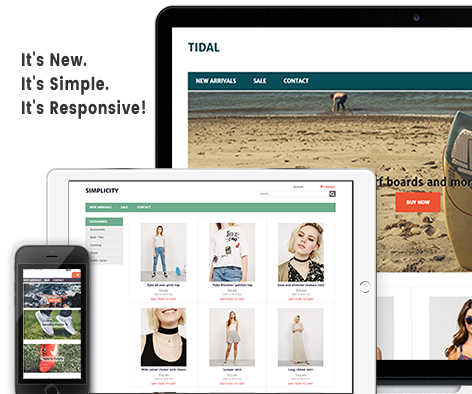The InstanteStore team just launched another 3 NEW responsive and mobile friendly templates (yay!) (more…)
Ecommerce Web Design
Things to Consider When You Want to Build an Online Store

An online store is, in essence, not much different than a physical one. eCommerce merely occurs in a different medium. Building an online store requires all the same attitudes and prep-work. Hence, we’ll draw parallels to a real-world retail store.
3 Painless eCommerce SEO Stylings from a Wizard!

Ah, search engine optimization. I have a strong love-hate relationship with the artform. I’m certain its true for anyone who has the will to dabble in the arcane craft of SEO.
Alas! SEO for eCommerce websites is even more complicated and mystical than traditional SEO. In the everlasting quest for the holy grail of Google’s first result ranking, many throw our hands up in despair and resign from the task altogether. Some persist doggedly, adamant that SEO “must-be-done”.
Fewer still go about it in a practical & time efficient manner, tackling the problem with a mixture logic and creativity, never actually enjoying it.
Of course, InstanteStore comes with a built in “SEO Wizard” to help you take care of the back-end and technical aspects of SEO, like Schema implentation. There are still practices that you should undertake to build upon that foundation.
I’ve been studying a whole bunch of eCommerce websites, so I’m sharing several good and bad trends I’ve noticed among merchants in 2016. The craft may seem mysterious in theory, but practically, the execution is often straightforward.
What Search Engines Want
The most common issue I notice when browsing shopping websites is the amount of duplicated content. This usually stems from having multiple product pages for variations of the same item. Fix it by making sure all variations (size, colour, material) are on the same product page and displayed via drop-downs or radio buttons. We know search engines are contemptuous of duplicate content, providing zero value to audiences. So let’s make this a forbidden practice. The tech exists for this fix, hence a technological obstacle is no excuse for it.

An even weaker version of the duplicate content affliction is copy pasting supplier product descriptions, often to the point where many merchants have the same exact copy. I’m glad to report that it’s not something I notice much anymore, but it does happen so I’m just letting you know: this is sooo forbidden, there should be a wall of “NOPE” around it. If your products suffer from contentimus duplicatitis, do whatever it takes to make it original. Hire a copywriter if you must to make sure your product pages don’t contain copy that anyone else has.
It’s not efficient to create unique copy for thousands of product pages though. Instead, using your web analytics tool (you have one right?), pick your most popular product pages for original content.
What People Want
Another problem I often encounter is the worrying lack of search query optimization. Unless you sell iPads or a popular product, don’t use product names as your search indicator. Instead target the product type: tablets, insect repellent, autumn chrysanthemum arrangements, Halloween cookies, etc.
Think about what the shopper is searching for-what they actually type into search engines when they begin their digital journey. This will help determine the kind of language used to reach your pages. So if your insect repellent is called “Bugone”, maybe people will be more likely to find it if you optimized for the search term: “bug spray”, or “insect repellant”.

Search engines (and people too) love it when a page matches the users intent exactly. It’s logical. So if a page matches a shopper persona, it should show up when a person in searching for information. If a page matches a buyer persona, it should be listed when the person is ready for product options.
#Winning 2016
Atop a meadow of clouds, perched firmly at the top of SERPS is Polyvore. It’s a fashion shopping site, where they know their audience well and the social tech they favour. They have thus given shoppers the ability to create bundles of products, making up their own styles that they can upload so other users can browse and shop. Users can also interact with other bundles and share them across social media.

I’m pleased to say that I’ve noticed an increase in merchants opting for user generated content. This is great for SEO because it means older indexed pages are regularly updated, letting search engines know that your pages still have activity and thus are still relevant. Up till recently, user generated content was mostly in the form of user reviews and testimonials. As companies like Polyvore show us, there’s more than one way to skin this dragon!
User generated content is beneficial in several ways:
- Your community will contribute content of their own, cutting down a chuck of your workload. A community interaction is a healthy one.
As mentioned above, new content keeps your pages refreshed and indicates activity to search engine bots. It’s why online forums do well at SEO.
The community your create benefits from it as well because they get recognition for putting together popular outfit ensembles, creating an enjoyable user experience.
J!NX clothing give their shoppers the ability to post pictures of themselves with their new loot, and earn rewards for it too:

A quick and simple fix for user generated content is to add social media feeds to your most popular pages. This is a good strategy if you don’t have much engagement on your site but have a responsive audience on your social media channels.
*Remember that people want to engage with brands they see, so don’t hold back. On social media you should be tagging your posts with relevant people, and make use of those #tags to get your content in front even people who would otherwise not be able to see your content.
Which brings us to…
Social Media Marketing. SEO is no longer confined to making search engines like your pages and content. It’s now more important to make your content visible (and popular) on different channels on the web, because people who engage with your content are indicting to search engines that your content is relevant. Hence the more people engage with it, the more priority search engines will give it.

It’s the reason you’ll see outdated content on the first page of many results, because it was once the most popular result for a search, and nothing new has come along that is as popular, even if there are more relevant contemporary piece available.
These channels include the various social media platforms like Facebook, Instagram, Twitter, Youtube (yes!) as well as community forums.
In the past, back-links used to hold a lot of weight in SEO ranking, so much that internet marketers hacked the system and created lots of artificial links a ranking boost. Given enough effort a page could rank number 1 on Google with a day or two. Naturally this led to a poor experience for the user, and so things aren’t as simple anymore.
So my suggestion is this: the next time you are on Facebook, spend a few minutes to join a group relevant to your market and promote your own content with a link and a few words about it. I’m not even talking about a blog post-though it can be. I’m talking about a specific product. I say start promoting a product you personally use because it will help word your promotional post in a fluid and genuine manner. Use that as practice before writing about products you aren’t as passionate about and springboard yourself into a natural rhythm.

If you do this for a single piece of content on multiple groups, across various social networks, you will start to get in front of many eyeballs. That’s a great first step. Once your foundation is solid, audience engagement will be an easier obstacle to demolish. If you can only spare time to promote one piece of content to one group, once a week, that is infinitely more than getting zero social signals. So do it for as long as you can before losing yourself to the void…
The key to tying social media with SEO is the user engagement. The goal is to have lots of people sharing your content over a short period of time, which is the “virality” factor that a social media marketer so intensely craves. It isn’t necessary to go all Ice Bucket Challenge every single time. What works in the long run is the cumulative effects of content promotion.

As with anything digital, always be tracking and analysis your traffic, your search terms and your rankings. Figure out what’s working and replicate the process from there. A methodological process will ensure you start getting results faster.
And that’s all folks!
As you can gather, social interaction has a significant role in contemporary SEO, although many traditional tactics do still carry weight. It’s all about the ratio of importance the engines assign to each ranking factor.
Doing SEO by bolstering my social media marketing efforts works well for me. It covers all my priorities: achieving KPI goals, what I have time for, and what I enjoy. Try something yourself and see what works best for you based on what you can manage to get done.
Mastering SEO isn’t for everyone, but it doesn’t mean only the most seasoned practitioners are capable of conjuring clever spells. You’ll see that most of the time you’ll be getting incremental results over long periods of time. Once in awhile, stars align and magic wills itself into being without much help, resulting in a massive surge of traffic, engagement and popularity. It’s an incredible rush to see it happen before your eyes as weeks and months of work pay off all at once!
InstanteStore New 2016 eCommerce Templates Released!

InstanteStore V8’s first round of eCommerce templates are more image-heavy, designed to catch the attention of your visitors.
Social Psychology in eCommerce: The Gravity of Trust

The Ultimate Value
Trust is a vital concept when it comes to social psychology in eCommerce. Trust appears wherever risk, uncertainty and dependency exists, and is something online shops strive to earn from their shoppers. Consumers trusting an online retailer is important in establishing transactional behavior.
It is a weighty concept that is often taken for granted because we believe we understand it, despite the range of definitions it carries. To consumers, doing business with an eCommerce merchant represents a step into the unknown thus creating positive trust-beliefs will help result in positive intentions (sales) from consumers.
According to findings in “The Science of Shopping Cart Abandonment” by Charles Nicholls: 74.6% of new shoppers will not return after abandoning a shopping cart, and so persuading shoppers to complete a purchase on their very first visit is of utmost importance for long-term survival, and why nurturing initial trust is so crucial in this step of the journey.
As Andrea Petersen stated in her Wall Street Journal piece:
“It seems that trust equals revenue, even online.”
Understanding The Role Of Trusting Beliefs
Each party of an eCommerce transaction looks to eliminate risk and uncertainty by finding ways to increase trust. We acomplish this by building beliefs about the beneficial characteristics of the vendor. These characteristics can be applied to beliefs about the competence, benevolence, integrity and predictability of an online store.

1. Belief in competence is when a shopper believes that the merchant possesses the ability to deliver goods or services as promised, whether it is in terms of volume, delivery time, pricing or quality. Shoppers also want to know you are an expert who has the necessary skills to provide a convenient solution, and that you are dynamic– able to meet challenges that arise without excuses.
We see this come up a lot in the world of eCommerce. Belief in your competence leads to a positive action towards your business, and that trust carries so much weight that when broken it leads to anger, frustration and reputation damage within the online community. On the flipside, if that belief is reinforced by actual competence, the goodwill generated has the potential to spread like wildfire, leading to more belief and further positive actions.
2. Belief in benevolence is when a shopper believes the merchant is caring, morally conscious, responsive and is capable of goodwill towards him or her. A merchant that cultivates the belief of benevolence would not have the perception of taking advantage of the shopper by feeding their fears (eg. the fear of missing out), rather is one that acts in their best interest, that the service is not a scam, and is always willing to communicate matters with the client.
3. Belief in integrity is when shoppers trust that a merchant is honest, credible and reliable in their dealings by being truthful and upfront about things like pricing and delivery times rather than forgoing the truth in order to make sales. Merchants that demonstrate integrity accept the responsibility of the good-faith placed upon them and is the standard bearer of fulfilling promises and ethical obligations, like keeping client information secure.
4. Belief in predictability doesn’t actually have positive or negative values associated with it. It means that a shopper has the belief that your actions are consistent enough to the point that he/she can predict your behavior in a normal transactional situation, regardless of whether your actions are good or bad.
A customer may have high belief in the predictability of Amazon to fulfill delivery of an order within 5 days. A high level of belief in predictability would also forecast that a confirmation email and invoice will be sent immediately after purchase. Having belief in the predictability of an online merchant also means that the merchant’s readiness to handle a client’s needs will never alter over time.
These four beliefs complement each other and often one lead to another depending on the buying stage of a customer and what their current relationship is with your brand (fresh, has heard of you before or has conducted business with you before). The most important one is always the one that addresses the current fear of a customer and facilitates positive behaviors.
 If a customer fears being scammed, then their integrity belief is the most important. If the customer fears getting a bad deal like paying a higher markup price, then benevolence belief takes precedence. Fear that credit card details might be inadvertently stolen during the checkout process will rely on the competence belief that your technical ability to prevent such theft will address this issue.
If a customer fears being scammed, then their integrity belief is the most important. If the customer fears getting a bad deal like paying a higher markup price, then benevolence belief takes precedence. Fear that credit card details might be inadvertently stolen during the checkout process will rely on the competence belief that your technical ability to prevent such theft will address this issue.
Belief in these characteristics leads to trusting intentions, which is when a customer shows the intention of relying on the merchant despite being unable to control the merchants actions. The amount of belief a shopper has will affect their readiness to perform trust related internet behaviors compared to traditional shopping instances, since online shoppers have less control over their experience such as handing over sensitive personal information, or not being able to immediately determine the quality of a product or service.
These behaviors are actions like sharing sensitive information, adding products to cart or making a purchase by completing the checkout process, and are a natural consequence of their trust in or beliefs about the online store.
Facilitating Trust
Rather than allowing customers to bumble haphazardly through the trust-intention-action process, there are of course things merchants can do to guide them through it to assure them that their beliefs are in safe hands and their intentions will have positive results.
A privacy policy lets your customers know that you are ethical when it comes to collecting their personal information (integrity). As such they are more likely to be open to sharing their personal information with you (intention). When a customer is more willing to share information then they are naturally more likely to act on it (behavior).
Not having a privacy policy in place on your online store can help you lose customers while being upfront about how you collect, store, and share personal data will allay the fear customers have about how their data is collected and used. They tend to be long walls of text filled with legalese that in a way discourage people from reading them.
Twitter has a very clear and well formatted privacy policy laid out which you can find here. Making it easily accessible for the average user shows transparency, which is a concept closely related to being trustworthy.
As the saying goes: those with nothing to hide hide nothing.
Trust seals & SSL certificates suggest that a site provides technical security for payment forms to prevent middleman interventions or network eavesdropping.
Koray Özpolat at the University of Rhode Island hypothesizes that the four factors surrounding the effectiveness of trusts seals are cart value, retailer’s sales volume, shopper experience and number of other trust seals displayed:
Cart Value
Trust seals are more effective towards the completion of higher value shopping carts.
The value of a shopping cart simply means how much the total value of the products in the cart amounts to. Higher value purchases are more risky and thus entail a higher level of risk-aversion thus providing information pertinent to security and privacy helps reduce perceived risk.
Retailer Size
Online retailers with a smaller sales volume benefit more from the presence of the trust seal than larger online retailers.
This is tied-in with an online store’s reputation. Someone who has never shopped on Amazon.com would have less concerns about the ability of the company to protect their information, becuase it is a well established marketplace that has served millions of customers worldwide. As such smaller eCommerce sites would be required to take even greater measures to address these concerns. Customers would naturally feel less comfortable shopping at your store if it is new or relatively unheard of.
Past Experience
The effect of trust seals diminish the more frequently a user shops at a particular online store.
It means that trust is being developed over time, and with the benefit of having completed successful transactions before, the need to be convinced of trustworthiness is gradually eliminated as the customer updates his or her perception of the merchant.
Varied Trust Seal
The impact of trust seals on completing the checkout process has diminishing returns as the number of displayed trust seals increases.
In other words, displaying all the trust seals you can get your hands on won’t do much to convince your customers to make a purchase past the first few unique or synergetic ones, such as a seal that addresses security together with seals the address identity and privacy. Having multiple seals that address the same concerns is pointless.
In terms of shopping cart abandonment, the research found that the optimal number of seals to display is only 2 and that there is a reverse effect (u-turn) on trust with an increasing number of seals. Hence it is crucial to avoid information overload when displaying trust seals as it may cause confusion or skepticism.
What’s interesting is a particular result from a study published by Christian Holst suggesting that the perception of security is more important to online shoppers than its actually technical security ability. The trust seals are often nothing more than certification of a site or company about its customer relations or business practices, whereas SSL seals are what suggest technical security on the site.

Image: Baymard Study
There are many places you might display your security certifications and credentials, on your front page, on a product page, or on the footer, but the most important location to build trust is at the checkout process, the page where a customer will enter their payment details. It is at this point that a person has the most alarm bells going off, so it is here that it becomes of utmost importance to build confidence in the ability to protect one’s privacy.
It should be standard practice by now for an online business to be engaging with customers, both individually and as an community. From a trust perspective, it also manages to convey that you are a merchant possessing the positive belief characteristics mentioned above, that it is benevolent, competent, honest and predictable. These positive traits solidify customers trust which lead to positive trust behaviors.
Interaction can occur through any channels your site has available, such as social media, email, phone, video calling, or even a support system on the site itself. It involves customer service, feedback, marketing and general socializing.
A great example of customer-facing eCommerce is Dell’s built-to-order model, which was once a thing Alienware did. With this model they were able to build stronger and deeper relationships with their customers.
This is interaction as well, since analyzing how your customers interact with your store (you) and understanding their shopping behavior and decisions can give you valuable data about how to better serve them. It can help you improve your design, user experience, content, and set pricing, which lead to increased shopping cart completion rates.
By building a good reputation a merchant is able to bring about purchasing behaviors. Improving reputation will also improve beliefs because reputation is the anecdotal evidence/rumour that the merchant has positive characteristics, while trusting beliefs are first-hand, and as stated above, lead to intentions.
The trend now is to prominently display customer testimonials as social proof about a good service rendered, and it is standard to have customer reviews on product pages, as these constitute a secondary reputation, that of the product you sell on your store.
Brand recognition happens naturally, but should also happen through your own efforts with marketing campaigns. Consumers are also more likely to trust merchants that actively advertise their marketplace as it shows an investment in growth. It is unlikely that shoppers want to have business dealings with companies they think are in it for the short-term, as this will hamper an important part of transactions, which is after sales support.
Links to a reputable site can provide the extra push to assure customers that you run a reputable site. Quality outbound links suggests that you run a good company because you are good company, by way of transference.
The initial trust a shopper has for an unknown store will be more strongly influenced by a better known domain when there is a connection (hyperlink) between the two. This transference of trust can be achieved in many ways, not just by linking to other domains, but also by connections to influential individuals within online communities such on social networking sites and forums.
On online marketing forums such as the Warrior Forum, vendors and affiliates gain reputation by being active in the hyper-niche communities found within, creating trust and favourable reputations, allowing each other to cross promote their services, confident in the knowledge that each other are in high reputation standing among the public. After all, nobody wants to affiliated with shady dealers or those with a poor reputation – whether by perception or concrete.
Reputation is also strengthened when there is a link between your online store and a physical location, which we cover in the next item.
Having a proper channel to receive inquiries and complaints goes a long way in creating trust. It shows your users that there is a real person running things, and that you are available to be contacted should the need arise.
Some businesses choose not to disclose any contact details whatsoever, instead having a contact form to direct queries. Whether this might be a good practice for your business is something only you can determine by understanding your customer base. Others businesses are fully transparent, and it seems to work for them.
The amount of information you are willing to share is totally up to you, however a Contact page should be the bare minimum, then adding social media links, email and then live chat support as the need arises. You may also want to add business hours and your address if it is applicable.
Being active in updating the content of your store instils a sense of comfort whereby a customer knows that he/she is not in a deadzone. Fear of being in an abandoned site will obviously lead to phenomenal bounce rates. Updating your inventory or updating the product information helps your store stay fresh and alive.
Consider creating a content strategy for your products by mapping out time-periods for content updates. Several merchants I work with now choose to have a content cycle for individual products, which means not uploading all the content right away, but doing it over a period of time. For example uploading the product and details right away, then in week 2 adding a long-form product description or even a dedicated blog post about it, and in the third or fourth week uploading a video of the product as either a review, a tutorial, or the now very popular unboxing video format.
Even if your store features products with slow development cycles, you can work around this by generating blog content and being active on social networks about your regular operations or by events, expos or roadshows you attend. These updates also have the benefit of conveying to your customer that you are a creator and community participant, not solely a profit maker- or: Benevolent.

The social psychology of trust in eCommerce is about putting yourself in your customer’s seat, figuring out where your customers will have gaps in trust, then patching those gaps up. Empathizing with your consumers and their trust needs requires taking action on providing information to ease them into a trustworthy relationship with you.
As you can see, understanding the fears and pain points of your eCommerce users is paramount in increasing conversions. Trust exists differently for different people at different stages of their buying journey.The tactics mentioned above will alleviate common fears most customers have when encountering a new online shopping store. They work in tandem by gradually reducing risk-aversion and increasing belief in not getting ripped off.
The Bottom Line:
Shoppers need to trust you to provide them with a reliable, safe and convenient service before they will ever conduct online business with you.
If you found this post useful, please consider sharing our eCommerce blog with those who will also benefit from it. Do also comment with your thoughts/examples/horror tales below, or if you want a more private conversation you can reach me via Email. Thanks!
What’s NEW With The InstanteStore v8 Admin Panel

After several months of hard work, the team at InstanteStore is proud to announce the launch of our NEW Admin Panel.
InstanteStore v8 New Checkout System

Joyous Sunday To You
A match made in heaven, today Desmond and a very shy and busy Wai Hoong introduce our improved checkout process.
It’s so much faster than before, which will help your customers alot!
The really had fun with it & we think you will too, so watch their short video here!
InstanteStore v8 New Admin Panel

Greetings!
Today it’s Terry’s turn to showcase his hard work.
The new admin panel is sleek and designed to be user friendly and easily accessible, with customization to boot!
Get a glimpse into the mind of one of our talented engineers here!
InstanteStore v8 New Popup Lead Generator

Hello again!
Today we’ve got “Lord of the Strings” Ryan to showcase his masterpiece: The new Popup Generator
The email sign up form is designed to help merchants capture visitor contact details. Ryan’s been working hard to make sure it’s easy to use so everyone can get to growing your stores!
Watch him in action here, and toss some karma to the guy with a comment!
InstanteStore v8 New Template Editor

